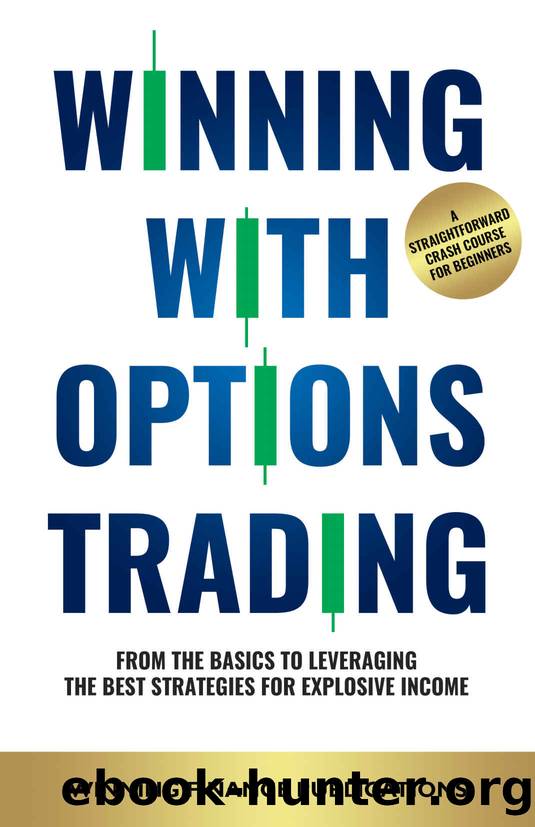Winning With Options Trading: From The Basics To Leveraging The Best Strategies For Explosive Income â A Straightforward Crash Course For Beginners by PUBLICATIONS WINNING FINANCE

Author:PUBLICATIONS, WINNING FINANCE [PUBLICATIONS, WINNING FINANCE]
Language: eng
Format: epub
Published: 2023-02-28T00:00:00+00:00
TECHNICAL INDICATORS FOR OPTIONS TRADING
Having discussed trendlines, let's turn to specific technical indicators relevant to options traders. Many of these indicate overbought and oversold levels. These are relevant to option traders because when looking at an oversold or overbought stock, you can expect a price reversal in the near future, and as already mentioned, success in trading options depends on getting the timing right.
Relative Strength Index (RSI)
The relative strength index, or RSI, measures when a security is overbought or oversold. The RSI values range between 0 and 100. When the number is 70 or above, it is considered an indication that the asset is overbought. If the value is 30 or below, it is to considered to be an indication that the asset is oversold. It works by comparing the magnitude of recent gains to recent losses over a given period of time to measure the security's speed and change of price movements in an attempt to determine whether the conditions are overbought or oversold.
This momentum indicator usually works better when analyzing options on individual stocks than with options on indexes (that track more than one stock).
Bollinger Bands
Bollinger bands measure volatility increases and decreasesâsomething we already know to be important when dealing with options tradingâas a way of adapting to price expansions and contractions. Practically speaking, when looking at a chart with Bollinger bands added, one will see three lines going through the chart; the top and bottom lines are the actual Bollinger bands, and the middle one is a simple moving average (SMA). The SMA tells us the asset's average price over a certain period of time. The bands create a boundary on either side of the SMA, showing where the price is overbought (when near the top band), and where oversold (when near the bottom band). The bands will be narrow if the stock price has a narrow range. The bands will be wide if the stock price has a wide range of volatility.
Bollinger Bands can be used in a few ways. One common way traders use it is to indicate when a price reversal is due. This would be the case if the price of a stock moved outside the bands. The bands can be used at a basic level to confirm a trend.
Money Flow Index (MFI)
The momentum flow index uses data such as volume and price to understand the influx and outflux of cash in a specific stock over time (usually 14 days). It gives what traders call "trading pressure." Because it uses volume data as an important parameter, this momentum indicator is better used in individual stocks and long-term trades. Ultimately, this indicator, which is evaluated between 0 and 100, tells us if a stock is oversold or overbought. Anything below 20 indicates that the stock may be oversold, while anything above 80 indicates that it may be overbought.
The MFI can also offer us a heads-up and alert us if the stock's trend is shifting. This is when there are divergences. A divergence occurs when,
Download
This site does not store any files on its server. We only index and link to content provided by other sites. Please contact the content providers to delete copyright contents if any and email us, we'll remove relevant links or contents immediately.
| Analysis & Strategy | Bonds |
| Commodities | Derivatives |
| Futures | Introduction |
| Mutual Funds | Online Trading |
| Options | Portfolio Management |
| Real Estate | Stocks |
Rich Dad Poor Dad by Robert T. Kiyosaki(6517)
Pioneering Portfolio Management by David F. Swensen(6261)
How To Win Friends and Influence People by Dale Carnegie(4474)
The Money Culture by Michael Lewis(4138)
The Dhandho Investor by Mohnish Pabrai(3729)
The Wisdom of Finance by Mihir Desai(3698)
Liar's Poker by Michael Lewis(3416)
Fooled by Randomness: The Hidden Role of Chance in Life and in the Markets by Nassim Nicholas Taleb(3083)
The ONE Thing by Gary Keller(3034)
Mastering Bitcoin: Programming the Open Blockchain by Andreas M. Antonopoulos(3015)
The Intelligent Investor by Benjamin Graham Jason Zweig(3014)
Rich Dad Poor Dad: What The Rich Teach Their Kids About Money - That The Poor And Middle Class Do Not! by Robert T. Kiyosaki(2930)
How to Day Trade for a Living: Tools, Tactics, Money Management, Discipline and Trading Psychology by Andrew Aziz(2925)
Investing For Dummies by Eric Tyson(2923)
How to Win Friends and Influence People by Dale Carnegie(2885)
The Psychology of Money by Morgan Housel(2812)
Market Wizards by Jack D. Schwager(2673)
Zero Hour by Harry S. Dent Jr. & Andrew Pancholi(2632)
How to Pay Zero Taxes, 2018 by Jeff A. Schnepper(2623)
